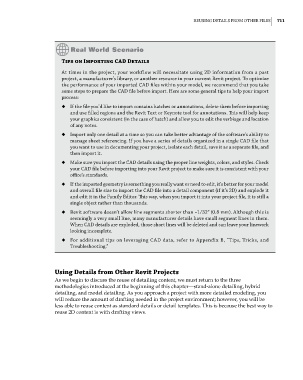Page 745 - Divyank Tyagi
P. 745
|
reusing Details FroM otHer Files 711
Tips on Importing CAD Details
at times in the project, your workflow will necessitate using 2D information from a past
project, a manufacturer’s library, or another resource in your current revit project. to optimize
the performance of your imported CaD files within your model, we recommend that you take
some steps to prepare the CaD file before import. Here are some general tips to help your import
process:
u ◆ if the file you’d like to import contains hatches or annotations, delete them before importing
and use filled regions and the revit text or Keynote tool for annotations. This will help keep
your graphics consistent (in the case of hatch) and allow you to edit the verbiage and location
of any notes.
u ◆ import only one detail at a time so you can take better advantage of the software’s ability to
manage sheet referencing. if you have a series of details organized in a single CaD file that
you want to use in documenting your project, isolate each detail, save it as a separate file, and
then import it.
u ◆ Make sure you import the CaD details using the proper line weights, colors, and styles. Check
your CaD file before importing into your revit project to make sure it is consistent with your
office’s standards.
u ◆ if the imported geometry is something you really want or need to edit, it’s better for your model
and overall file size to import the CaD file into a detail component (if it’s 2D) and explode it
and edit it in the Family editor. This way, when you import it into your project file, it is still a
single object rather than thousands.
u ◆ revit software doesn’t allow line segments shorter than ~1/32ʺ (0.8 mm). although this is
seemingly a very small line, many manufacturer details have small segment lines in them.
When CaD details are exploded, those short lines will be deleted and can leave your linework
looking incomplete.
u ◆ For additional tips on leveraging CaD data, refer to appendix B, “tips, tricks, and
troubleshooting.”
Using Details from Other revit Projects
As we begin to discuss the reuse of detailing content, we must return to the three
methodologies introduced at the beginning of this chapter—stand-alone detailing, hybrid
detailing, and model detailing. As you approach a project with more detailed modeling, you
will reduce the amount of drafting needed in the project environment; however, you will be
less able to reuse content as standard details or detail templates. This is because the best way to
reuse 2D content is with drafting views.
c16.indd 711 5/3/2014 11:34:33 AM

